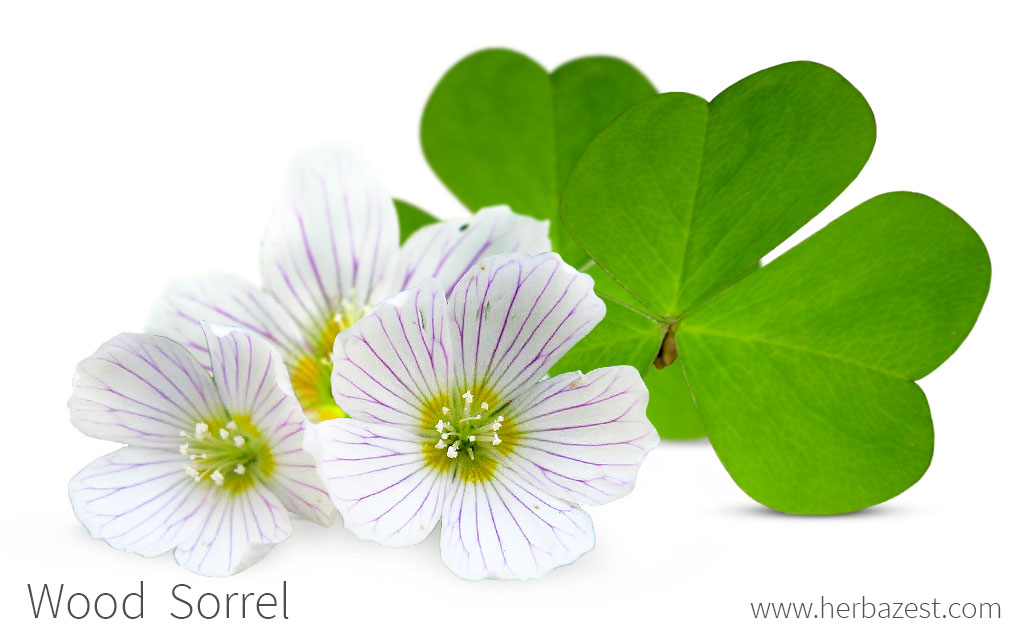Wood sorrel, also known as oxalis, is native to every continent on the planet, excluding Antarctica. It is often mistaken for shamrock and clover because of the similarities between the plants' leaves. While many know of wood sorrel for its sour-tasting leaves, this is an herb that has many valuable medicinal uses.
Wood Sorrel Medicinal Properties
Health Benefits of Wood Sorrel
Wood sorrel has recently become of more interest to researchers because of the wide range of uses it seems to possess. Based on recent studies, the main wood sorrel's benefits are mostly useful for:
Protecting the liver. Wood sorrel has been shown to protect the liver from damage and even help to promote faster healing.
Soothing digestive upset. Stomach issues like ulcers and diarrhea can be calmed by the use of wood sorrel.
Promoting healing of small wounds. Antimicrobial compounds in wood sorrel prevent wounds from becoming infected, and wood sorrel can even speed up the healing process.
How It Works
Wood sorrel contains an impressive range of phytochemical constituents, mainly flavonoids, tannins, phytosterols, phenols, fatty acids, galacto-glycerolipid, and volatile oils.
The flavonoids and phenols in wood sorrel leaves seem to be responsible for the hepatoprotective action of the herb. These antioxidant compounds have proven effective in protecting the liver from harmful substances, such as the ones contained in paracetamol, a popular medication used to treat fever and pain, that has shown high levels of hepatotoxicity when taken too frequently or in excessive quantities.1,2
The same phytochemicals of wood sorrel have been tested in the treatment of gastrointestinal upset and diarrhea. Methanolic extracts of the herb have shown to be as effective as loperamide, a standard antidiarrhea medicine. These active principles in Oxalis species are thought to halt diarrhea by inhibiting motility and secretions of the small intestine.3
The flavonoids and phenols in wood sorrel are also antimicrobial agents, capable of soothing ulcers by increasing mucus secretion and inhibiting the bacterial growth that cause this gastrointestinal condition.4 The same antiseptic properties of the herb help prevent infection in wounds.
Wood sorrel's content in vitamins C (ascorbic acid) and E corroborates its efficacy as a folk remedy for treating scurvy.
Other herbs with hepatoprotective effects are chicory, hepatica, and milk thistle, whereas amaranth, kiwi, and sweet potato are great for improving digestive issues.
Wood Sorrel Side Effects
Because of its high content of oxalic acid, the herb has been listed among other potentially poisonous plants by the Food and Drug Administration (FDA). Overconsumption of wood sorrel can cause internal organ damage. Many other commonly-eaten plants contain oxalic acid as well, but because wood sorrel has a high concentration of the acid, it should be taken with more caution.
Side effects of consuming wood sorrel may include diarrhea, nausea, rash, stomach irritation, eye damage, kidney damage, and swelling of the throat. Wood sorrel may also cause crystals to form in the blood, which may travel to and damage the kidneys, heart, lungs, or liver.
Wood Sorrel Cautions
There are no known medical interactions with wood sorrel. It is not recommended for children as well as women who are pregnant or breastfeeding. It may also negatively affect those with bleeding disorders, stomach and intestinal disorders, or kidney disease.
- Medicinal action Antimicrobial, Hepatoprotective
- Key constituents Phenolic compounds, flavonoids
- Ways to use Decoctions, Hot infusions/tisanes, Tincture, Ointment, Syrup
- Medicinal rating (2) Minorly useful plant
- Safety ranking Use with caution

How to Consume Wood Sorrel
Although wood sorrel is not well known as either a food or herbal remedy, there are several different ways to consume the plant in medicinal and culinary preparations.
Natural Forms
Infusion. Wood sorrel tea can be consumed primarily to calm an upset stomach, but it also supports liver health.
Decoction. A few drops of decoction taken a few times per day can be very useful for relieving diarrhea or for protecting the liver from damage.
Herbal Remedies & Supplements
Syrup. A syrup made from wood sorrel can be used as a flavoring, but it is also very beneficial for soothing ulcers and other stomach issues.
Ointment. Applied externally, wood sorrel ointment can speed up healing of small wounds and prevent wound infections.
Tincture. Made from wood sorrel, it can be added to lotions for external application, which can soothe small wounds. It can also be mixed with drinks or food to relieve ulcer pain.
Wood sorrel is not produced commercially for culinary use, but it is so commonly and easily grown that many choose to plant it to include in their own recipes. It is known for its slightly sweet, tart taste. It can be used in a lemonade-like beverage or can be cooked and added to soups and stews. It can also be used raw, either eaten alone as a snack, added to salads, or used as a seasoning.
- Edible parts Leaves
- Edible uses Flavoring, Beverage
- Taste Tart

Growing
There are many species of wood sorrel grown all over the world, so there is likely to be one that will thrive in nearly any environment. While many people consider wood sorrel to be a weed, it can be a beautiful and useful plant to grow in a backyard or herb garden.
Growing Guidelines
The wood sorrel plant is propagated by seeds or by bulbs, depending on the variety of the plant.
The best soil for any oxalis plant is well-drained, moist, fertile soil, such as the type of soil found in temperate woodlands. Some varieties may prefer clay soil.
Adding compost to the soil is advised as it can help to provide the nutrients that help wood sorrel thrive.
The wood sorrel plant grows in soil with a wide range of pH levels; while some varieties may grow best in acidic soil, they can be grown in soil with a pH level of 4.5 - 7.0.
Oxalis plants should be planted approximately 8 - 10 inches (20 - 25 cm) apart.
While it can withstand direct sun in the morning, wood sorrel grows best in damp, shady locations.
Many varieties of Oxalis will germinate between 60 - 80°F (15 - 26°C), although the many different varieties are likely to have different temperature requirements.
Wood sorrel often prefers milder climates as it cannot survive harsh winters, and - with the exception of tropical varieties - it tends to become dormant in very hot temperatures.
Wood sorrel can typically grow in zones 5 - 11, although different varieties will have different restrictions.
Plant wood sorrel in the fall or the early spring.
Slugs, spider mites, and aphids can pose a threat to wood sorrel.
The most common disease to afflict the plant is powdery mildew.
- Life cycle Perennial
- Harvested parts Flowers, Leaves
- Light requirements Morning sun with afternoon shade, Full shade
- Soil Clay loam, Well-drained
- Soil pH 4.5 – 5.0 (Very strongly acidic), 5.1 – 5.5 (Strongly acidic), 5.6 – 6.0 (Moderately acidic), 6.1 – 6.5 (Slightly acidic), 6.6 – 7.3 (Neutral)
- Growing habitat Cool temperate regions, Temperate climates, Warm climates
- Planting time Early spring, Fall
- Plant spacing average 0.3 m (0.98 ft)
- Propagation techniques Bulbs and corms
- Potential insect pests Aphids, Mites, Slugs
- Potential diseases Powdery mildew
Additional Information
Plant Biology
The wood sorrel plant is generally a perennial, but depending on the variety and the temperature where it is grown, it may behave like an annual. The plant and its leaves are very small and delicate until the root grows large enough to support the plant, at which point the leaves may reach up to one inch (2.5 cm) in diameter. The leaves are heart-shaped, similar in appearance to clover, and can range from green to pink to deep purple. Flowers are very small, approximately one half-inch (1 cm) in diameter, and can be white, yellow, or pink. Wood sorrel grows either by a rhizome, which sends up new shoots from below ground as it grows, or a stolon, which is an above-ground stem that can re-root as it grows.
Classification
Wood sorrel is the collective name for many different species in the genus Oxalis, which is part of the Oxalidaceae family, along with other 900 species. So far, there are over 800 recognized species of wood sorrel belonging to the Oxalis genus.
Species Related to Wood Sorrel
While there are an abundance of species of wood sorrel, some are more widespread and are more commonly used in medicinal remedies. Oxalis acetosella, or common wood sorrel, is one of the most-encountered varieties. Another popular species, especially in the United States, is yellow wood sorrel, or O. stricta. However, one of the most studied varieties is O. corniculata, or creeping wood sorrel.
Although the many different species may differ slightly in their benefits and uses, they seem to be similar enough to provide the majority of the same benefits.
Historical Information
In the past, sorrels were a popular remedy for scurvy as they have a very high vitamin C content.
Wood sorrel is native to every continent aside from Antarctica, and it grows in a variety of different climates and environments. Although it has never been widely or commercially cultivated for its taste or for its medicinal uses, it has been used to make herbal remedies throughout history.
Oxalis species have been used since ancient times in different parts of the world. Native Americans used to make a poultice by boiling the leaves of sheep's sorrel to place it over wounds, warts, and corns. They also used the plant as food. Wood sorrel has been used in similar ways in Iceland, where it now has a protected status.
Popular Beliefs
Wood sorrel is often confused with shamrock, the famous plant that Saint Patrick used to illustrate the Christian idea of the Holy Trinity. It is often marketed as shamrock around Saint Patrick's Day, but in reality, shamrock is most likely a type of clover.
Other Uses
Gardening. Wood sorrel is often grown in gardens as an ornamental plant, especially its tropical varieties, which tend to have more vibrant and unusual colored flowers.
Dye. The wood sorrel plant can also be used to manufacture a yellow dye.
Although wood sorrel is often treated as a weed, this underrated plant contains a wealth of health benefits. Its ability to protect the liver, soothe stomach issues, and heal small wounds makes it a valuable medicinal herb.
- Other uses Dye
Sources
- Edible Wild Plants, pp. 177 - 190
- Icelandic Herbs and Their Medicinal Uses
- International Journal of Pharmaceutical Sciences and Research, Phytochemistry and pharmacology of Oxalis corniculata linn.: A review, 2012
- International Journal of Phytomedicine, The Botany, Chemistry, Pharmacological and Therapeutic Application of Oxalis corniculata Linn - A Review, 2011
- James Ong's Homegrown Revolution, p. 82
- MyScience, Phytochemical analysis and antibacterial activity of Oxalis corniculata; a known medicinal plant, 2006
- University of Florida, False shamrock, aka woodsorrel, is a weed we notice around St. Patrick’s Day
Footnotes:
- African Journal of Pharmacy and Pharmacology. (2012). Antioxidant and hepatoprotective effects of Oxalis corniculata against carbon tetrachloride (CCl4) induced injuries in rat. Retrieved November 9, 2022 from: https://academicjournals.org/journal/AJPP/article-full-text-pdf/38B3EBB33227
- Indian Journal of Experimental Biology. (2013). Hepatoprotective activity of Oxalis corniculata L. ethanolic extract against paracetamol induced hepatotoxicity in Wistar rats and its in vitro antioxidant effects. Retrieved November 9, 2022 from: http://nopr.niscpr.res.in/bitstream/123456789/26436/1/IJEB%2052%282%29%20147-152.pdf
- Camerun Journal of Experimental Biology. (2005). Antidiarrhoeal activity of aqueous and methanolic extracts of Oxalis corniculata Klotzsch. in rats. Retrieved November 9, 2022 from: https://www.ajol.info/index.php/cajeb/article/view/37933
- Indian Journal of Pharmaceutical Sciences. (2012). Gastroprotective effect of Oxalis corniculata (whole plant) on experimentally induced gastric ulceration in Wistar rats. Retrieved November 9, 2022 from: https://pubmed.ncbi.nlm.nih.gov/23204622/







